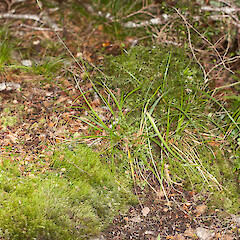Carex horizontalis
Common name
bastard grass, hook sedge
Synonyms
Uncinia caespitosa var. minor Kük.; Uncinia horizontalis Col.; Uncinia rupestris Raoul
Family
Cyperaceae
Flora category
Vascular – Native
Endemic taxon
Yes
Endemic genus
No
Endemic family
No
Structural class
Sedges
NVS code
The National Vegetation Survey (NVS) Databank is a physical archive and electronic databank containing records of over 94,000 vegetation survey plots - including data from over 19,000 permanent plots. NVS maintains a standard set of species code abbreviations that correspond to standard scientific plant names from the Ngä Tipu o Aotearoa - New Zealand Plants database.
UNCRUP
Chromosome number
2n = 88
Current conservation status
The conservation status of all known New Zealand vascular plant taxa at the rank of species and below were reassessed in 2017 using the New Zealand Threat Classification System (NZTCS) – more information about this can be found on the NZTCS website. This report includes a statistical summary and brief notes on changes since 2012 and replaces all previous NZTCS lists for vascular plants.
Please note, threat classifications are often suggested by authors when publications fall between NZTCS assessment periods – an interim threat classification status has not been assessed by the NZTCS panel.
- Conservation status of New Zealand indigenous vascular plants, 2017 . 2018. Peter J. de Lange, Jeremy R. Rolfe, John W. Barkla, Shannel P. Courtney, Paul D. Champion, Leon R. Perrie, Sarah M. Beadel, Kerry A. Ford, Ilse Breitwieser, Ines Schönberger, Rowan Hindmarsh-Walls, Peter B. Heenan and Kate Ladley. Department of Conservation. Source: NZTCS and licensed by DOC for reuse under the Creative Commons Attribution 4.0 International licence.
2017 | Not Threatened
Previous conservation statuses
2012 | Not Threatened
2009 | Not Threatened
2004 | Not Threatened
Distribution
Endemic. New Zealand: North, South and Chatham Islands.
Habitat
A mainly forest dwelling species. Mostly montane in the North Island (300–1000 m a.s.l.) but becoming more common in lowland areas in the southern South Island. Irrespective of elevation, common throughout forested areas on the Chatham Islands.
Detailed description
Plants loosely tufted or forming a dense turf. Culms 100–400 × c. 0.5 mm, drooping or nodding, glabrous, usually slightly scabrid just below inflorescence; basal bracts light brown, not shining. Leaves widely spreading, 4–7 per culm, < mature culms, c. 1.5–2.0 mm wide, bright green, soft, channelled, scabrid on margins and upper surface towards apex. Spikes 30–60 × 3–5 mm., occasionally bracteate, female flowers 5–33, lax towards base of spike with internodes to 6 mm long, more crowded above with internodes 0.5–1.0 mm long. Glumes ± = or us. < utricles, deciduous, ovate, acute or acuminate, hyaline with green midrib or very pale brown. Utricles 4.5–6.0 × 1.0–1.5 mm, ovate-lanceolate, trigonous, green to greenish brown, usually smooth except for a prominent lateral nerve but occasionally with a few less distinct nerves, somewhat spreading when ripe, slightly contracted below to a stipe c. 1.0–1.5 mm long, tapering above to a beak of 1–2 mm long.
Similar taxa
Carex horizontalis is closely allied to Carex minor (Kük.) K.A.Ford (a species many regard as part of C. horizontalis). In the field C. horizontalis can be distinguished from Carex minor by its densely leafy, tufted, rather than loosely tufted growth habit, leaves which are 1.5–2.0 mm rather than < 1 mm wide, and utricles which are 1.0–1.5 mm rather than c. 1 mm diameter. Carex minor tends to flower earlier (September– October) than C. horizontalis (October–November).
Flowering
October–November
Fruiting
December–April–(July)
Propagation technique
Easily grown from fresh seed and by division of established plants - though these may take a while to settle. Prefers a permanently damp, shaded site in a deep rich soil.
Etymology
carex: Latin name for a species of sedge, now applied to the whole group.
Where To Buy
Not commercially available.
Attribution
Description adapted from Moore and Edgar (1970).
References and further reading
Moore LB, Edgar E. 1970. Flora of New Zealand, Volume II. Indigenous Tracheophyta: Monocotyledones except Gramineae. Government Printer, Wellington, NZ. 354 p.





